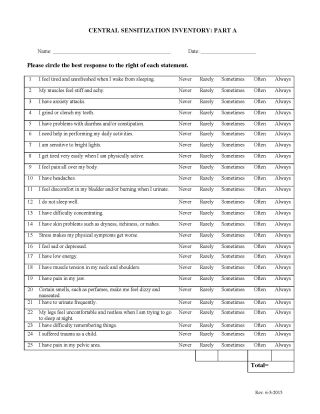Chronic Pain
How to Check if Nerve Sensitization Is a Factor in Your Pain
You can evaluate pain with the central sensitization inventory.
Posted December 27, 2023 Reviewed by Kaja Perina
Key points
- Nerve sensitization is often a factor in chronic pain states such as chronic back pain and migraines.
- Sensitization is an invisible cause of pain that does not show on medical tests.
- The CSI serves as a starting point, but a diagnosis of nerve sensitization requires a medical professional.

Nerve sensitization often contributes to chronic pain states, such as back pain, migraines, and irritable bowel. Sensitization is an invisible cause of chronic pain; it does not show on medical tests.
The Pattern
Sensitization is the result of abnormal processing of pain by the brain. Here are the clinical signs that suggest its presence.
- Pain persists long past the expected healing time. For example, you strained your back nine months ago, but your back still hurts. A muscle strain should heal in three months or less.
- The symptoms spread beyond the boundary of the injury. Instead of a golf ball area of pain in your lower back, the pain spreads across the back and down your thighs.
- A marked increase in sensitivity to stimuli develops. For instance, light touch or pressure on your back hurts.
- The presence of non-pain symptoms, including fatigue, poor sleep, and brain fog. You develop symptoms that affect your entire body.
Screening for Sensitization

A clinical tool or symptom evaluator that screens for nerve sensitization is the central sensitization inventory (CSI). The tool is free.
The CSI asks about common sensitization symptoms, such as headaches and stiff, achy muscles. It also inquires about the non-pain symptoms like fatigue and difficulty sleeping.
The measure considers associated factors that influence sensitization symptoms, including stress, mental health, and prior trauma. The CSI looks at whether stress makes physical symptoms worse. It asks about anxiety attacks, feeling sad, and any trauma suffered as a child. All are additional aspects in the development and worsening of sensitization syndromes.
The CSI score is calculated by assigning scores of zero, one, two, three, or four to the response categories ranging from “never” to “always.” After answering the questions, your total score is calculated within a range from zero to 100, with higher scores suggesting more sensitization.
A score of 40 or higher suggests significant symptoms from sensitization.
The CSI tool aims to develop awareness of potential sensitization symptoms. The measure is not meant as a self-diagnostic tool since diagnosis requires consideration of other factors not included in it.
A licensed medical provider should make a diagnosis of nerve sensitization. The CSI is helpful to get started but should be interpreted with the help of your medical provider.
I discuss sensitization in-depth in my book, Sunbreak: Healing the Pain No One Can Explain.
References
Tom G. Mayer et al., “The Development and Psychometric Validation of the Central Sensitization Inventory,” Pain Practice 12, no. 4 (September 2011): 276–85. https://doi.org/10.1111/j.1533-2500.2011.00493.x.


